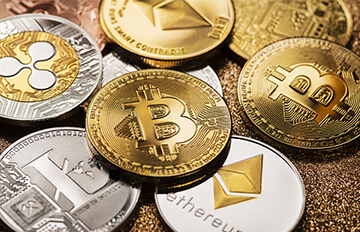The key to increasing wealth is investing, and various asset classes present various opportunities. The three common investment possibilities that are examined in this essay are gold, real estate, and cryptocurrencies. Investors can learn whether these assets are suitable for their portfolios by contrasting their traits, dangers, and prospective returns.
Cryptocurrency Investment
Investing in cryptocurrencies entails purchasing and maintaining digital assets like Bitcoin, Ethereum, or other altcoins. Decentralization, potential anonymity, and global accessibility are just a few of the distinctive features that this sort of investing offers. However, it also entails several dangers, including high price volatility, unpredictability in the regulatory environment, and cybersecurity threats.
Before investing in this market, investors interested in cryptocurrencies should do extensive study, grasp the technology underlying them, and evaluate their risk tolerance.
Features of Cryptocurrency
Based on blockchain technology, cryptocurrencies are digital assets that provide decentralization, transparency, and perhaps anonymity. They are limited in availability and work apart from conventional financial systems.
Risks Associated with Cryptocurrency
Volatility:Extreme price volatility, which causes big swings in value over brief periods, is one of the main characteristics of cryptocurrencies.
Regulatory Risks: As the regulatory environment for cryptocurrencies evolves, it may have an impact on the price and application of cryptocurrencies.
Cybersecurity: Because cryptocurrencies are digital, they are vulnerable to hacking, hacks, and theft. Security measures must be given priority by investors.
Returns from Cryptocurrency
The growth potential of cryptocurrencies is enormous, and early adopters have made significant profits. However, past results do not guarantee future results, and there are dangers involved in investing in cryptocurrencies.
Gold Investments

Buying actual gold is one way to invest in it, as is buying gold-backed financial products like exchange-traded funds (ETFs) or gold mining equities. Gold is widely considered a store of wealth and a safe-haven asset. It provides stability in times of economic turbulence, serves as a safeguard against inflation, and has a lengthy track record of wealth preservation.
Features of Gold Investment
Gold has long been used as a store of wealth since it is a physical, rare precious metal. Due to its scarcity and antecedent stability, it is viewed as a safe-haven asset.
Risks Associated with Gold Investments
Price Variations: Although gold is more stable than cryptocurrencies, its price can nevertheless change due to variables like the state of the economy, world politics, and investor emotion.
Storage and Security: Safe storage and insurance are necessary for physical gold, both of which can be expensive extras. Additionally, it could be stolen or lost.
Returns from Gold Investment
Gold has a history of acting as a hedge against inflation and economic unpredictability and has been shown to maintain value over the long term. The profits on gold might fall short of crypto currencies’ promise for rapid development, though.
Property Investments
Purchasing tangible real estate assets like homes, businesses, or land is referred to as investing in real estate. The benefits of investing in real estate include prospective rental income, long-term appreciation, and tax savings. They do, however, also have dangers, including liquidity, market swings, continuous maintenance costs, and prospective vacancies.
Features of Property Investment
Acquiring tangible real estate assets, such as residential or commercial properties, is part of investing in property. The property offers potential long-term appreciation as well as rental income.
Risks Associated With Property Investment
Market Conditions: A number of variables, including local market trends, interest rates, supply and demand dynamics, and economic conditions, can affect the value of real estate.
Upkeep and Costs: Owning real estate entails continuing costs for repairs, taxes, insurance, and prospective vacancies.
Limited liquidity: Selling real estate can be a time-consuming procedure, particularly in negative market conditions.
Returns from Property Investment
The possibility for long-term capital growth and rental income exists for property investments. An investment portfolio’s stability and diversification can be provided by real estate.
Conclusion
Investing in cryptocurrency, gold, or real estate each has its own qualities, dangers, and possible rewards. Cryptocurrencies have the potential for huge growth and considerable volatility, but they also carry higher dangers. Although historically conserving value, gold has not always offered the same potential for rapid expansion as other safe-haven assets.
Investments in real estate provide security, a source of income, and the possibility for growth, but they also come with market-dependent risks and illiquidity. When selecting among these assets, investors should carefully examine their risk appetite, investment objectives, and portfolio diversification plan.






